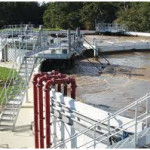The Sequencing Batch Reactor (SBR) is an activated sludge process designed to operate in a batch mode with aeration and sludge settlement both occurring in the same tank. Difference between SBR and activated sludge system is that the SBR tank carries out the functions of equalization, aeration and sedimentation in a time sequence.
An appropriately designed SBR process is a unique combination of equipment and software. Working with automated control reduces the number of operator skill and attention requirement. There are basically five stages to treatment: Fill, React, Settle, Decant and Idle.
Aeration times vary according to the plant size and the composition/quantity of the incoming liquor. The settling stage is usually the same length in time as the aeration. The sludge is allowed to settle until clear water is on the top 20%-30% of the tank volume. The decanting stage most commonly involves the slow lowering of a scoop or “trough” into the basin. SBR is ideally suited when nitrification, denitrification and biological phosphorus removal is necessary
Advantages of Sequencing Batch Reactor
– Small footprint
– Simple Design.
– Maintains consistent effluent quality due to batch settling method.
– Suitable for variable organic and hydraulic load.
– No Clarifier required reducing the spare requirement
– Effective quiescent settling
– No sludge recirculation
– Biological Nutrient removal.

